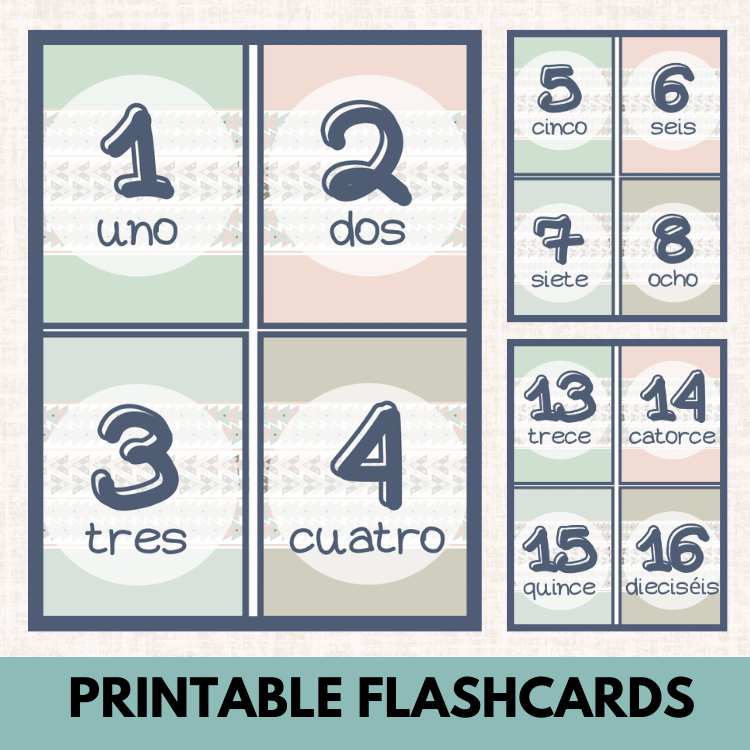Hey there, Joyful Journey Makers! Today, we’re talking about a classic yet powerful tool that we’ve all used at some point—flashcards. Whether you’re teaching the basics or reinforcing tricky concepts, flashcards have the ability to make learning fun, interactive, and effective. And when it comes to language learning, especially numbers in Spanish, they can be game-changers!
But like any tool in your teaching kit, flashcards have their pros and cons. Let’s dive into how you can get the most out of them in your Spanish classroom and how to turn something simple into a joyful learning experience.
The Pros of Flashcards: Why They Work
Flashcards are the OG of learning tools for a reason! Here’s why they still shine in today’s modern classroom:
- Repetition Reinforces Learning: Flashcards are perfect for repetitive practice, which is crucial for language acquisition. The more students see a number and its Spanish equivalent, the more it sticks!
- Active Recall: Flashcards encourage students to actively recall information. Instead of passively absorbing content, they’re challenged to think, which helps deepen their understanding and retention.
- Versatility: You can use flashcards in a hundred different ways—quick quizzes, group games, partner practice, or even independent review. The possibilities are endless!
- Engagement: Students love a good challenge, and flashcards naturally turn learning into a fun, fast-paced game. They create opportunities for students to stay engaged while practicing pronunciation, identifying numbers, and improving fluency.
The Cons of Flashcards: What to Watch Out For
While flashcards are a fantastic tool, there are a few things to keep in mind:
- Rote Learning Trap: If not used creatively, flashcards can lead to memorization without true understanding. We want our students to understand what they’re learning, not just spit out answers!
- One-Dimensional Practice: Flashcards focus on specific information, which is great for building foundational knowledge, but they shouldn’t be the only tool in your toolbox. Mix it up with other activities to ensure students develop well-rounded language skills.
- Monotony: Let’s be honest—if used the same way every day, flashcards can get a little stale. But don’t worry, we’ve got you covered with some playful, creative ways to use these beauties in your Spanish class!
Flashcards for Learning Numbers in Spanish: Let's Spice Things Up!
Now, let’s talk about how to turn my gorgeous set of Spanish Numbers 1-20 Flashcards into an engaging classroom experience that goes beyond simple memorization. You can use these cards to introduce, practice, or assess students’ ability to identify, pronounce, and understand numbers in Spanish—all while having fun!
Here are some classroom games to reinforce learning:
- Speed Round Challenge: Split students into pairs and see who can identify the numbers on the flashcards the fastest. Add a twist by having them pronounce the numbers out loud. First one to get through all their cards correctly wins!
- Mix & Match Madness: Shuffle the cards and have students work together to put them back in order. For an extra challenge, ask them to count out loud in Spanish as they arrange the cards in sequence!
- Greater Than/Less Than Showdown: Turn math into a Spanish learning game! Show two cards, and students must decide which number is greater or smaller. Have them shout out their answers in Spanish to reinforce number vocabulary and comparison terms.
- Number Scavenger Hunt: Hide flashcards around the classroom and give students a list of numbers in Spanish. They must find the matching card and pronounce it correctly to move on to the next one. It’s a great way to combine movement with learning!
- Flashcard Tic-Tac-Toe: Create a giant tic-tac-toe board on the floor and give students flashcards as their game pieces. They can only place a card down if they pronounce the number correctly. The first to get three in a row wins!
- Classroom Decor: Print and hang them around your classroom, on your cart if you’re traveling, or in the school hallway for consistent reinforcement!
The Gist of it All
The Bottom Line: Flashcards Can Be Magical!
When used creatively, flashcards can be so much more than just a memorization tool. They can become a fun, dynamic way to practice pronunciation, recognition, and comprehension in your Spanish classroom. Plus, with my Spanish Numbers 1-20 Flashcards, you’ll not only have a versatile tool but a beautiful, thoughtfully designed resource that your students will love.
So whether you’re introducing numbers, reinforcing them, or looking for a quick, no-prep game, flashcards are here to make language learning fun, effective, and oh-so-engaging.
Ready to bring some joy into your Spanish lessons? Grab my Spanish Numbers 1-20 Flashcards and watch your students light up as they master numbers in a whole new way!

Resources
Culatta, R. (2018, November 30). Dual coding theory (Allan Paivio). InstructionalDesign.org. https://www.instructionaldesign.org/theories/dual-coding/
Dual coding: A teacher’s guide. Structural Learning. (2021, October 26). https://www.structural-learning.com/post/dual-coding-a-teachers-guide
Learning a language with flashcards: What the Science says. Tandem. (n.d.). https://tandem.net/blog/learning-a-language-with-flashcards-what-the-science-says
Marinelli, Tiffany P. Hwa, Christine M. Lohse, Matthew L. Carlson, Harnessing the power of spaced repetition learning and active recall for trainee education in otolaryngology, American Journal of Otolaryngology, Volume 43, Issue 5, 2022, 103495,ISSN 0196-0709, https://doi.org/10.1016/j.amjoto.2022.103495.
Quinn, S. (2024, June 30). The benefits and challenges of spaced repetition flashcard apps for language classes. The FLTMAG. https://fltmag.com/spaced-repetition-flashcard-apps/




